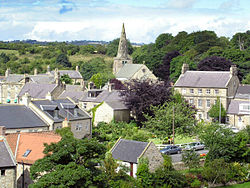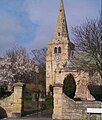Warkworth, Northumberland
| Warkworth | |
| Northumberland | |
|---|---|
 Warkworth village and church, viewed from the northeast | |
| Location | |
| Grid reference: | NU246057 |
| Location: | 55°20’42"N, 1°36’40"W |
| Data | |
| Population: | 1,493 |
| Post town: | Morpeth |
| Postcode: | NE65 |
| Dialling code: | 01665 |
| Local Government | |
| Council: | Northumberland |
| Parliamentary constituency: |
Berwick-upon-Tweed |
Warkworth is a village in Northumberland, best known for its well-preserved mediæval castle, Warkworth Castle, its church and Warkworth Hermitage.
The recorded population of Warkworth was 1,493 in 2001.
The village sits in a loop of the River Coquet, about a mile from the North Sea, on the main A1068 road. It is thirty miles north of the county town, Newcastle upon Tyne.
An ancient bridge of two arches crosses the river at Warkworth, with a fortified gateway on the road mounting to the castle.
Warkworth is popular with visitors because it has a castle, church, hermitage, walks by the River Coquet, and is close to the Northumberland Coast, an 'Area of Outstanding Natural Beauty'.
Contents
Parish church
The parish church is the Church of St Lawrence. A church has existed on the riverside site in the village for around 1,200 years. St Lawrence church is a large and almost completely Norman building, which is unique in Northumberland. The first record of the village dates from 737 when King Ceolwulf of Northumbria gave the church and village to the Abbot and monks of Lindisfarne. In 1174, the church was the scene of a massacre when some 300 people were brutally butchered by Duncan, Earl of Fife during a Scottish raid.
History
Warkworth Castle was founded at an uncertain date; traditionally its construction has been ascribed to Prince Henry of Scotland in the mid-12th century, but it may have been built by King Henry II of England when he took control of England's northern counties. A timber castle was first documented in a charter of 1157–1164 when Henry II granted it to Roger fitz Richard. However it was considered "feeble", and was left undefended when the Scots invaded in 1173.
Roger's son Robert inherited and improved the castle. Robert was a favourite of King John, and hosted him at Warkworth Castle in 1213. The castle remained in the family line, with periods of guardianship when heirs were too young to control their estates. King Edward I stayed overnight in 1292 and John de Clavering, descendant of Roger fitz Richard, made the Crown his inheritor. With the outbreak of the Scottish Wars, Edward II spent money on building and strengthening castles, including Warkworth where he funded the strengthening of the garrison in 1319. Twice in 1327 the Scots besieged the castle without success.
During the 18th century the castle was allowed to languish. The south-west tower was falling apart and around 1752 part of the curtain wall east of the gatehouse was demolished (it was rebuilt towards the end of the century). The town and its historic ruins were by now attracting interest as a tourist destination, largely due to Bishop Thomas Percy's poem, The Hermit of Warkworth. In the mid 19th century Hugh Percy, 3rd Duke of Northumberland, undertook some preservation work. His successor, Algernon Percy, contracted Anthony Salvin to restore the keep.
In 1922 Alan Percy, 8th Duke of Northumberland, granted custodianship of the castle to the Office of Works which had been made accountable for the guardianship of ancient monuments.[1] The Duke's Chambers remained under direct control of the Percys. The Office of Works undertook excavations in the moat in 1924 and removed the custodian from the gatehouse. English Heritage, who now manage and maintain the site, succeeded as the castle's custodians in 1984.
In the 20th century Nikolaus Pevsner said of the imposing castle that the military engineer happened also to be a great architect. He went on: "Warkworth must be approached from the north. With its bridge, its bridge-tower, then Bridge Street at an angle, joining the main street up a hill to the towering, sharply cut block of the keep, it is one of the most exciting sequences of views one can have in England."
Warkworth once had a railway station, about a mile west of the village. It was designed by Benjamin Green for the Newcastle and Berwick Railway. The station closed to passengers in 1958 and closed to goods traffic in 1962.[2]
The village today
Due to Warkworth's popularity with visitors, the village cater for large numbers of visitors throughout the year. Facilities include three pubs, two hotels, a number of cafés, restaurants and tearooms, a chocolate shop and patisserie, a general store, and several galleries / boutiques.
Sport
- Cricket: Warkworth Cricket Club, formed in 1874
Pictures
| ("Wikimedia Commons" has material about Warkworth, Northumberland) |
|
|
Outside links
- Warkworth Drama Group
- Warkworth Parish Council
- Images of Warkworth
- Information on Warkworth, Northumberland from GENUKI
- Northumberland Communities - Warkworth
- warworthwebs
- St.Lawrence Church
- WarkworthVillageNorthumberland
References
- ↑ Summerson 1995, p. 44
- ↑ Hutton, Guthrie. Old Amble and Warkworth, Stenlake Publishing, 2014. ISBN 978-1-84033-657-3








